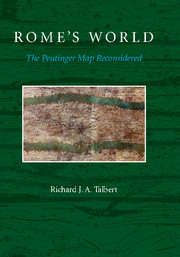Book contents
- Frontmatter
- Contents
- List of Plates, Figures, and Table
- Preface and Acknowledgments
- Abbreviations
- INTRODUCTION
- 1 THE SURVIVING COPY: HISTORY, PUBLICATION, SCHOLARSHIP
- 2 THE SURVIVING COPY: THE MATERIAL OBJECT AND ITS PALEOGRAPHY
- 3 THE DESIGN AND CHARACTER OF THE MAP
- 4 RECOVERY OF THE ORIGINAL MAP FROM THE SURVIVING COPY
- 5 THE ORIGINAL MAP
- CONCLUSION: THE MAP'S PLACE IN CLASSICAL AND MEDIEVAL CARTOGRAPHY
- APPENDIX 1 Latin Text Appended to the 1598 Engraving of the Map
- APPENDIX 2 English Translation of J. Kastelic, “Vodnikova kopija Tabule Peutingeriane” (trans. Gerald Stone)
- APPENDIX 3 Reflections on Vodnik's Copy of von Scheyb's Engraving
- APPENDIX 4 Vodnik's Latin Summary of Heyrenbach's Essay (National Library of Slovenia, Ljubljana, MS 1443)
- APPENDIX 5 Miller's Reconstruction of the Map's Western End
- APPENDIX 6 Wyttenbach's Claim: A Lost Piece of the Map Discovered
- APPENDIX 7 User's Guide to the Database and Commentary
- APPENDIX 8 User's Guide to the Map (A) and Overlaid Layers
- APPENDIX 9 User's Guide to the Outlining of Rivers and Routes on Barrington Atlas Bases (C–F), with Associated Texts: (a) Antonine Itinerary (ItAnt) Text with Journeys Numbered as on Map E, and (b) Bordeaux Itinerary (ItBurd) Text with Journeys Lettered as on Map F
- Notes
- Bibliography
- Index and Gazetteer
1 - THE SURVIVING COPY: HISTORY, PUBLICATION, SCHOLARSHIP
- Frontmatter
- Contents
- List of Plates, Figures, and Table
- Preface and Acknowledgments
- Abbreviations
- INTRODUCTION
- 1 THE SURVIVING COPY: HISTORY, PUBLICATION, SCHOLARSHIP
- 2 THE SURVIVING COPY: THE MATERIAL OBJECT AND ITS PALEOGRAPHY
- 3 THE DESIGN AND CHARACTER OF THE MAP
- 4 RECOVERY OF THE ORIGINAL MAP FROM THE SURVIVING COPY
- 5 THE ORIGINAL MAP
- CONCLUSION: THE MAP'S PLACE IN CLASSICAL AND MEDIEVAL CARTOGRAPHY
- APPENDIX 1 Latin Text Appended to the 1598 Engraving of the Map
- APPENDIX 2 English Translation of J. Kastelic, “Vodnikova kopija Tabule Peutingeriane” (trans. Gerald Stone)
- APPENDIX 3 Reflections on Vodnik's Copy of von Scheyb's Engraving
- APPENDIX 4 Vodnik's Latin Summary of Heyrenbach's Essay (National Library of Slovenia, Ljubljana, MS 1443)
- APPENDIX 5 Miller's Reconstruction of the Map's Western End
- APPENDIX 6 Wyttenbach's Claim: A Lost Piece of the Map Discovered
- APPENDIX 7 User's Guide to the Database and Commentary
- APPENDIX 8 User's Guide to the Map (A) and Overlaid Layers
- APPENDIX 9 User's Guide to the Outlining of Rivers and Routes on Barrington Atlas Bases (C–F), with Associated Texts: (a) Antonine Itinerary (ItAnt) Text with Journeys Numbered as on Map E, and (b) Bordeaux Itinerary (ItBurd) Text with Journeys Lettered as on Map F
- Notes
- Bibliography
- Index and Gazetteer
Summary
The “peutinger map,” which this study presents and analyzes, is today universally, and in my view correctly, considered to be no more than the sole surviving copy of a lost original. That original map – which is Roman in character even if not necessarily in date – must be this study's eventual concern, but it can only be approached through the copy, which is therefore addressed from many different perspectives in Chapters 2 through 4. This preliminary chapter establishes an essential foundation by treating the copy's discovery around 1500, its ownership over the next half millennium to the present, and above all the successive efforts to publish it and comprehend it.
DISCOVERY AND BEQUEST TO KONRAD PEUTINGER
The earliest testimony to the copy – the surviving Peutinger map – is its bequest to Konrad Peutinger in the will of Konrad Pickel (or Bickel; latinized as Celtis or Celtes); this was made on January 24, 1508, shortly before his death on February 4 at age forty-nine:
Item. Ego lego d(omi)no doctori Conrado Peutinger Itinerarium Antonini Pii, qui etiam eundem nunc habet; volo tamen et rogo, ut post eius mortem ad usum publicum puta aliquam librariam convertatur.
[Plate 1]I bequeath to Mr Dr Conrad Peutinger the Itinerarium Antonini Pii, the very same item that is at present in his possession; I wish, however, and request that after his death it should be turned over to public use, such as some library.
- Type
- Chapter
- Information
- Rome's WorldThe Peutinger Map Reconsidered, pp. 10 - 72Publisher: Cambridge University PressPrint publication year: 2010



